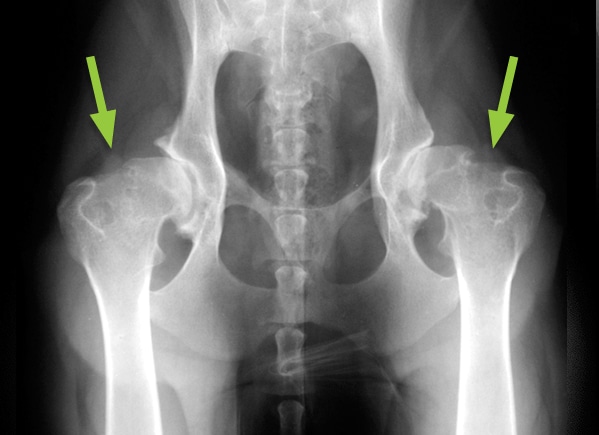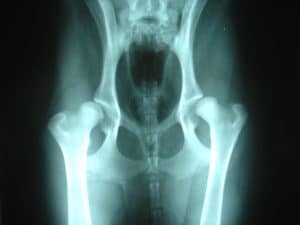HIP DYSPLASIA
Low- impact and high- resistance exrcises such as swimming are really well suited to dogs with joint conditions like dysplasia. This is because they help build up the larger buttock muscles, which help support the ball and socket hip joint.
It is a form of skeletal deformity that results from the abnormal growth of the hip bones. To overcome the structural deformities, the dog’s body tries to adapt itself to the normal situation. In doing so, there is the formation of degenerative joint diseases in dogs. Hip dysplasia is somewhat a genetic disease.
What are the distinctive features of Hip Dysplasia in dogs?
Hip dysplasia is a type of skeletal abnormality that induces pain and inflammation in the hip region. Most of the time, giant and large breeds of dogs are easy prey to this disease, but all the dog breeds are at the same risk. Moreover, for a better understanding of the aetiology of Hip Dysplasia, you need to understand the hip joint anatomy.
The hip joint consists of two bones; one comes from the femur and the other from the pelvic bone. It is a ball and socket joint that bears one part of the femur while the other forms the pelvic bone.
During puppy development, due to skeletal growth abnormalities, the ball and socket don’t fit each other. This condition results in friction, and ultimately degeneration of the hip joint occurs.
In later stages, the hip joint becomes stiff, and there is a loss of joint functions. It is a painful condition for the dog, but he/she tries to hide their pain in the early stages. That’s why; you need to pay attention to your dog’s gait pattern closely.
What could be the possible reasons for developing Hip Dysplasia?
A number of factors have an association with the occurrence of Hip Dysplasia in young dogs, but genetic factor tops the list. The hereditary skeletal disease is most common among the giant breeds of dogs. These include German Shepherd, Great Dane, Labrador Retriever, and Great Dane.
Genetic predisposing factor adds on due to improper diet, weight, exercises, and the growth rate. You can prevent the severity of conditions down the line by offering a special diet specially made for puppies of a large breed. It will help to reduce the excessive growth rate in these breeds.
Overweighing is another common problem that enhances the risk of Hip dysplasia in dogs by putting extra strain on joints. In the same way, too much and too little exercise practice also exacerbates the predisposing condition. All these conditions put extra stress on the abnormal hip joint, thus boot up its degeneration.
What symptoms are associated with canine Hip Dysplasia?
Symptoms of Hip Dysplasia are observable even at the age of four months. Others may experience the symptoms of osteoarthritis in conjunction with Hip Dysplasia. Normally, a dog owner cannot assess all the symptoms of Hip Dysplasia, but he/she can be pretty much sure that something is wrong.
The formation of inflammation, the extent of degeneration, and joint looseness all depend upon the duration of the disease. Some common indications include;
- Laziness or lack of activity
- Reduced range of motion
- Hesitation to climb stairs or jump
- Hind limb lameness
- Atrophy of thigh muscles (mass reduction)
- A feeling of severe pain
- Joint grating during a walk
- Abnormal gait pattern
- Hip joint stiffness
Whenever you see any abnormal gait pattern of your dog and the feeling of pain, it is best to see the veterinarian as soon as possible. The early diagnosis and treatment may handle the situation without any complication.
What is the treatment of Hip Dysplasia in Dogs?
The treatment of Hip Dysplasia has both surgical and non-surgical options. In mild conditions or low budgets, managing the lifestyle of the dog may prove beneficial. On the other hand, in severe cases, surgery is the only option to make your dog regain his/her mobility.
Sometimes, the dog is not in a state to bear the shock of surgical intervention. In such situations, the nonsurgical approach is appreciable. Moreover, your veterinarian can recommend the following tips depending upon the physical status of the dog.
- Physical therapy to regain full range of motion
- Reduction in weight to take off extra strain on joints
- Supplementation for joints to reduce degeneration
- Anti-inflammatory drugs like NSAIDs to relieve pain
- Joint fluid modifiers to enhance the fluid production in joints
Moreover, if the dog is facing the bad of the disease and has the ability to bear the surgical approach, then different options are available.
Three types of surgeries are available in veterinary practice that ensures the treatment of hip dysplasia in dogs. These include;
1-Pelvic osteotomy (double or triple)
2-Hip replacement
3-Osteotectomy of the femoral head
Depending upon the severity of degeneration and condition of the dog, a vet orthopaedic chose one of them. In this way, you can restore the movement of your dog.
Conclusion
Hip dysplasia is a common disease of the large breeds of dogs. The situation may get worse due to improper diet and exercise quality and quantity. Early diagnosis and medical management can ensure the treatment without much loss. Physiotherapy and Hydrotherapy are great ways to manage this condition, speak to your local vet today.



